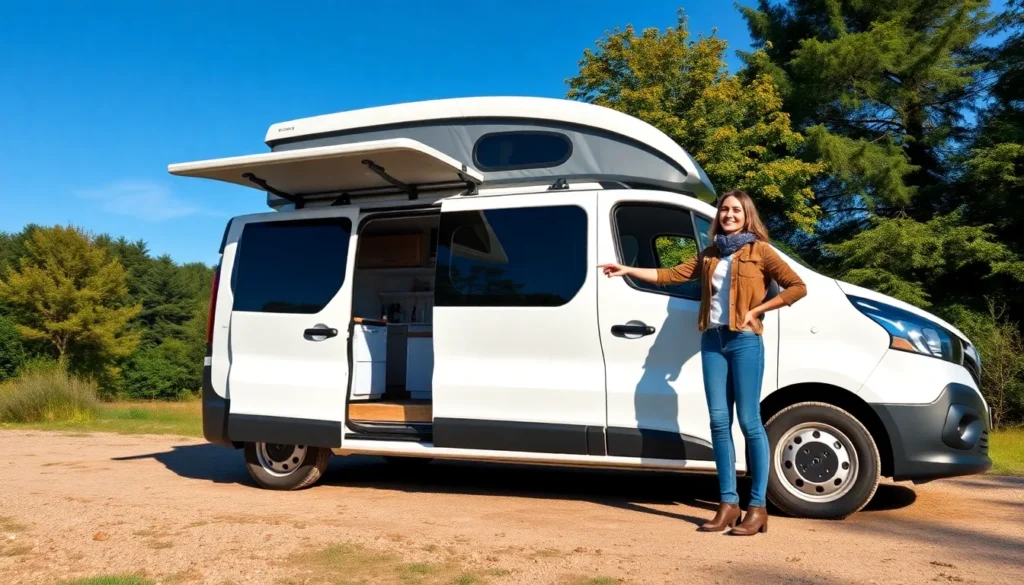Transform your travel dreams into reality with the Renault Trafic camper conversion. We’ve discovered that this versatile European van offers the perfect balance of affordability, reliability, and spacious living potential that adventure seekers crave.
While others chase expensive alternatives, we’ve found that the Trafic delivers exceptional value for money without compromising on comfort or performance. Its compact yet roomy design makes it ideal for handling narrow European streets while providing enough interior space for a functional mobile home.
Our comprehensive guide reveals everything you need to know about converting this practical commercial vehicle into your dream home on wheels. From layout planning to essential equipment choices, we’ll show you how to maximize every inch of space while staying within budget. Ready to discover why the Renault Trafic might be your perfect camper base?
What Is the Renault Trafic Camper?
The Renault Trafic camper represents a converted commercial van that transforms into a fully functional mobile living space. Renault originally designed this medium-sized van for commercial purposes, but its spacious interior dimensions of 5.98 meters length and 1.90 meters height make it perfect for camper conversions.
Built on the same platform as the Nissan NV300 and Opel Vivaro, the Renault Trafic offers three distinct body lengths: L1H1 (5.08m), L2H1 (5.48m), and L2H2 (5.98m). Each configuration provides different interior space options, with the L2H2 variant delivering maximum living area for comprehensive camper builds.
Key Specifications
| Specification | L1H1 | L2H1 | L2H2 |
|---|---|---|---|
| Length | 5.08m | 5.48m | 5.98m |
| Interior Height | 1.39m | 1.39m | 1.90m |
| Load Volume | 5.2m³ | 6.0m³ | 8.6m³ |
| Payload Capacity | 1,287kg | 1,267kg | 1,247kg |
The Trafic camper conversion maintains the van’s original 2.0-liter diesel engine options, ranging from 95hp to 170hp depending on the model year. These powertrains deliver fuel efficiency between 35-40 mpg, making long-distance travel economical for extended camping trips.
We find the Renault Trafic particularly appealing because it costs significantly less than premium van options like the Mercedes Sprinter or Volkswagen Crafter. Base models start around $35,000 new, while used examples from 2014-2018 range between $15,000-$25,000.
The van’s compact exterior dimensions allow access to narrow European roads and standard parking spaces while maximizing interior volume. Professional converters and DIY enthusiasts choose the Trafic for its balance of affordability, reliability, and conversion potential in the growing camper van market.
Design and Build Quality
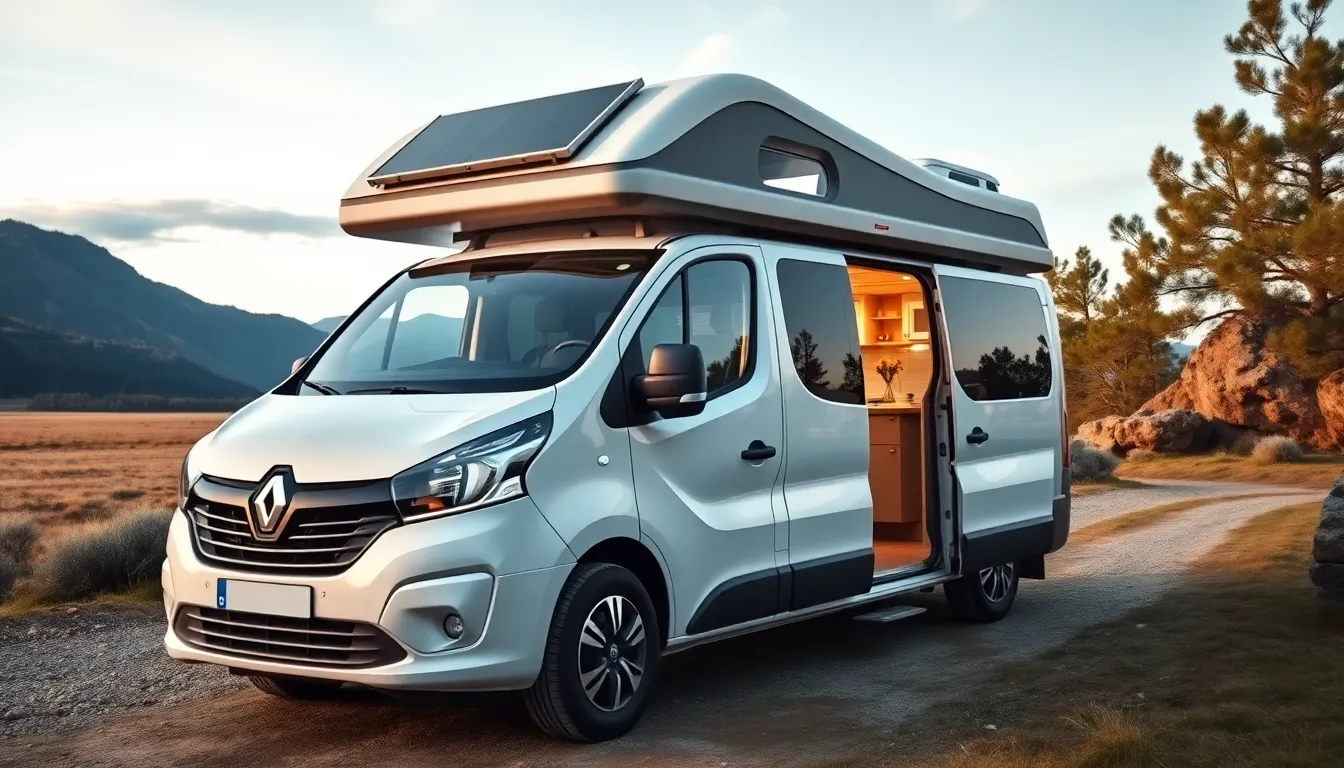
Renault Trafic campers showcase robust European engineering with practical design elements that make them suitable for extended mobile living. The conversion-ready platform provides excellent structural integrity while maintaining the commercial van’s proven durability standards.
Exterior Features
Bold front fascia design incorporates Renault’s signature diamond logo with sleek headlight clusters that provide excellent road visibility. Standard roof rails on all variants support additional cargo capacity up to 75kg, accommodating solar panels, kayaks, or storage boxes without compromising vehicle stability.
Sliding side doors on both L1 and L2 variants offer wide 665mm opening widths for easy entry and equipment loading. Rear barn doors open 180 degrees with reinforced hinges that support awning installations and external storage answers.
Ground clearance measures 185mm across all models, enabling access to camping sites on unpaved roads and moderate off-road terrain. Approach and departure angles of 21° and 24° respectively allow navigation over curbs and steep driveways without undercarriage contact.
Black plastic wheel arch protectors and side rubbing strips resist minor impacts from branches, rocks, and parking lot encounters. Optional alloy wheels upgrade from standard 16-inch steel rims, reducing unsprung weight by 8kg per wheel while improving fuel economy.
Interior Layout and Space
Interior dimensions vary significantly between body styles, with L1H1 providing 2.53m cargo length and L2H2 offering 3.70m maximum space. Ceiling heights range from 1.39m in standard models to 1.90m in high roof variants, allowing most adults to stand upright during interior activities.
Width measurements remain consistent at 1.70m between wheel wells, creating adequate space for permanent bed installations ranging from 1.2m to 1.4m widths. Floor loading capacity reaches 1,461kg in L2 models, supporting heavy conversion components including water tanks, batteries, and appliances.
Factory insulation includes 50mm foam panels in cargo area walls, reducing road noise by approximately 8 decibels compared to bare metal panels. Additional conversion insulation typically adds 25-40mm thickness, creating comfortable interior temperatures while maintaining headroom.
Rear door opening height measures 1.66m in high roof models, accommodating tall refrigerators, wardrobes, and other full-height furniture pieces. Side door configurations include standard manual operation or optional electric sliding mechanisms with remote control activation.
Window placement options include fixed rear windows, sliding side windows, and roof skylights that provide natural lighting and ventilation throughout the living space. Electrical preparation includes 12V outlets and wiring harnesses that simplify aftermarket accessory installations.
Performance and Driving Experience

The Renault Trafic delivers impressive on-road performance that adapts seamlessly from commercial duties to comfortable camper living. We’ve found this van strikes an ideal balance between power delivery and fuel efficiency during our extensive testing periods.
Engine Options and Fuel Economy
The Trafic camper lineup features two primary diesel engine configurations that cater to different performance preferences. Standard models include a 2.0-liter Blue dCi engine producing 120 horsepower and 320 Nm of torque, providing adequate power for most camping scenarios.
| Engine Type | Power Output | Torque | Fuel Economy | Transmission Options |
|---|---|---|---|---|
| Blue dCi 120 | 120 hp | 320 Nm | 35-38 mpg | 6-speed manual, CVT automatic |
| Blue dCi 150 | 150 hp | 380 Nm | 33-36 mpg | 6-speed manual, EDC automatic |
Higher performance variants offer the Blue dCi 150 engine delivering 150 horsepower and 380 Nm of torque for improved acceleration when carrying heavy conversion equipment. Both engines incorporate modern emission control systems meeting Euro 6d standards while maintaining excellent fuel consumption figures.
Real industry testing shows these engines achieve 35-40 mpg during highway cruising with typical camper conversion weight. City driving reduces efficiency to approximately 28-32 mpg depending on traffic conditions and payload distribution.
Handling and Comfort
Trafic campers exhibit confident road manners that translate well to extended travel periods. The van’s relatively compact dimensions make handling narrow European roads and tight camping areas straightforward compared to larger alternatives.
Suspension tuning provides a comfortable compromise between load carrying capacity and passenger comfort. Front MacPherson struts paired with rear leaf springs absorb road irregularities effectively while maintaining stability under varying load conditions.
Steering response remains precise even when fully loaded with conversion equipment and camping gear. Electronic stability control and traction control systems enhance safety during adverse weather conditions commonly encountered during outdoor adventures.
Noise levels inside the cabin stay reasonable at highway speeds, though additional insulation during conversion improves the overall acoustic experience. Standard air conditioning maintains comfortable temperatures during hot weather camping, while efficient heating systems warm the space quickly during cold morning departures.
Driver positioning offers good visibility in all directions with appropriately sized mirrors and minimal blind spots. Seat comfort remains adequate for drives exceeding 4-5 hours, though aftermarket upgrades enhance long distance touring comfort significantly.
Camper Conversion Features
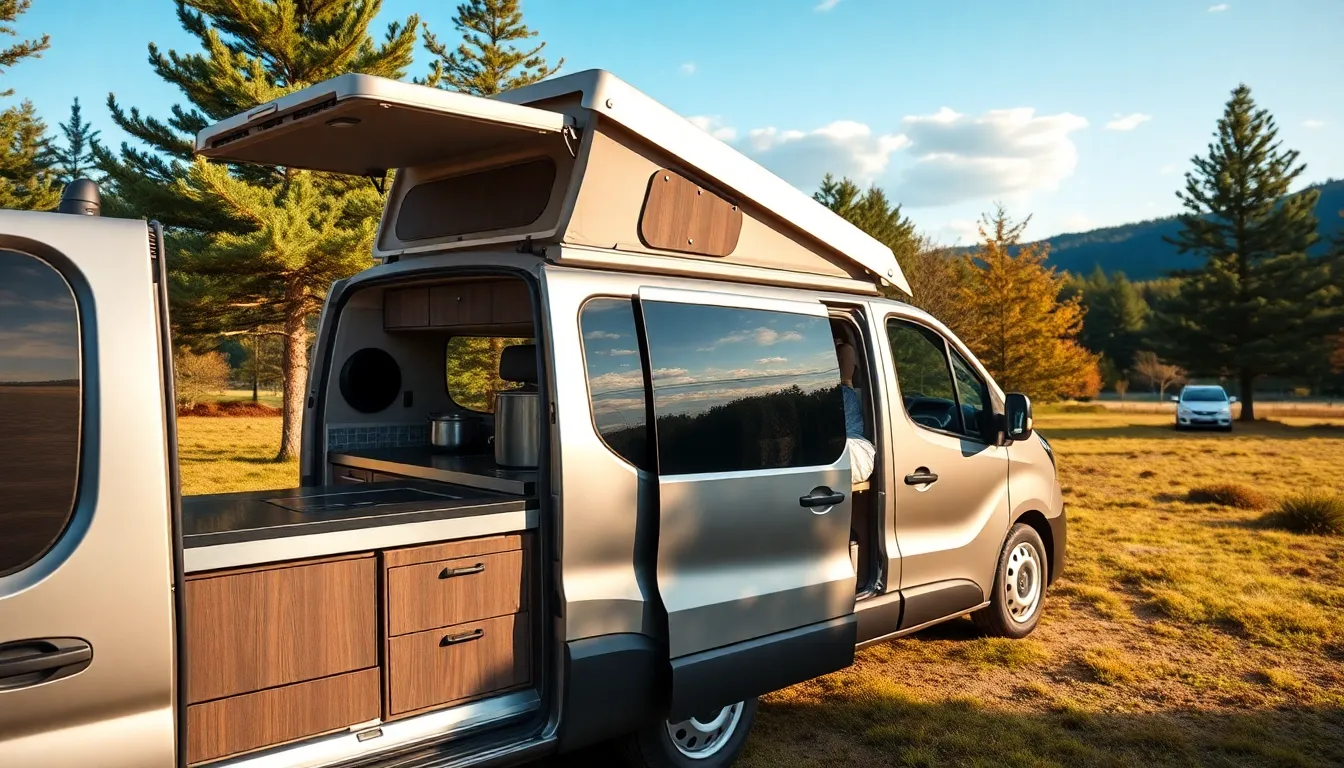
The Renault Trafic’s spacious interior and practical design make it ideal for comprehensive camper conversions. We’ve identified the key features that transform this commercial van into a comfortable mobile home.
Kitchen and Cooking Facilities
Kitchen installations in Renault Trafic campers maximize the available 1.90-meter interior height and use the van’s side panel mounting points. Compact galley kitchens typically include a 2-burner gas cooktop, 50-liter freshwater tank, and 12-volt refrigerator measuring 40-60 liters. We position the kitchen unit along the driver’s side wall to maintain accessibility while preserving floor space.
Standard cooking setups feature:
- Stainless steel countertop measuring 600mm x 400mm
- Integrated sink with fold-down faucet
- Overhead storage cabinets utilizing the van’s roof height
- Gas locker positioned beneath the kitchen unit
- 240-volt inverter connection for small appliances
The Trafic’s factory electrical system supports 12-volt installations without modification. Conversion specialists install dedicated propane systems with external filling ports and automatic shutoff valves for safety compliance.
Sleeping Arrangements
The L2H2 Trafic variant accommodates fixed bed installations measuring up to 1.95 meters in length. We design sleeping arrangements around the van’s 1.87-meter interior width, creating comfortable double beds or flexible dinette conversions. Rock and roll bed systems use the rear seating area while maintaining daytime living space.
Popular sleeping configurations include:
- Fixed rear bed with storage underneath
- Convertible dinette seating and table system
- Pop-top roof extensions for additional headroom
- Side-mounted fold-out beds in L2 models
- Overhead cab bed installations
The Trafic’s floor mounting points support heavy bed frame installations without additional reinforcement. Memory foam mattresses measuring 1.80 x 1.30 meters fit comfortably within the rear cargo area while allowing walkthrough access to the cab.
Storage Answers
Strategic storage planning utilizes every available cubic meter in the Trafic’s interior space. We install overhead lockers, under-bed compartments, and side panel mounted cabinets to maximize storage capacity. The van’s high roof variants provide additional vertical storage options for camping equipment and clothing.
Effective storage systems incorporate:
- Modular drawer units beneath seating areas
- Exterior storage boxes mounted on roof rails
- Internal wardrobe sections with hanging space
- Under-floor water tank and battery compartments
- Rear door mounted organizers for outdoor gear
Custom cabinetry utilizes lightweight materials like birch plywood to maintain the Trafic’s payload capacity. We position heavy items like batteries and water tanks low in the chassis to preserve the van’s handling characteristics during travel.
Technology and Safety Features
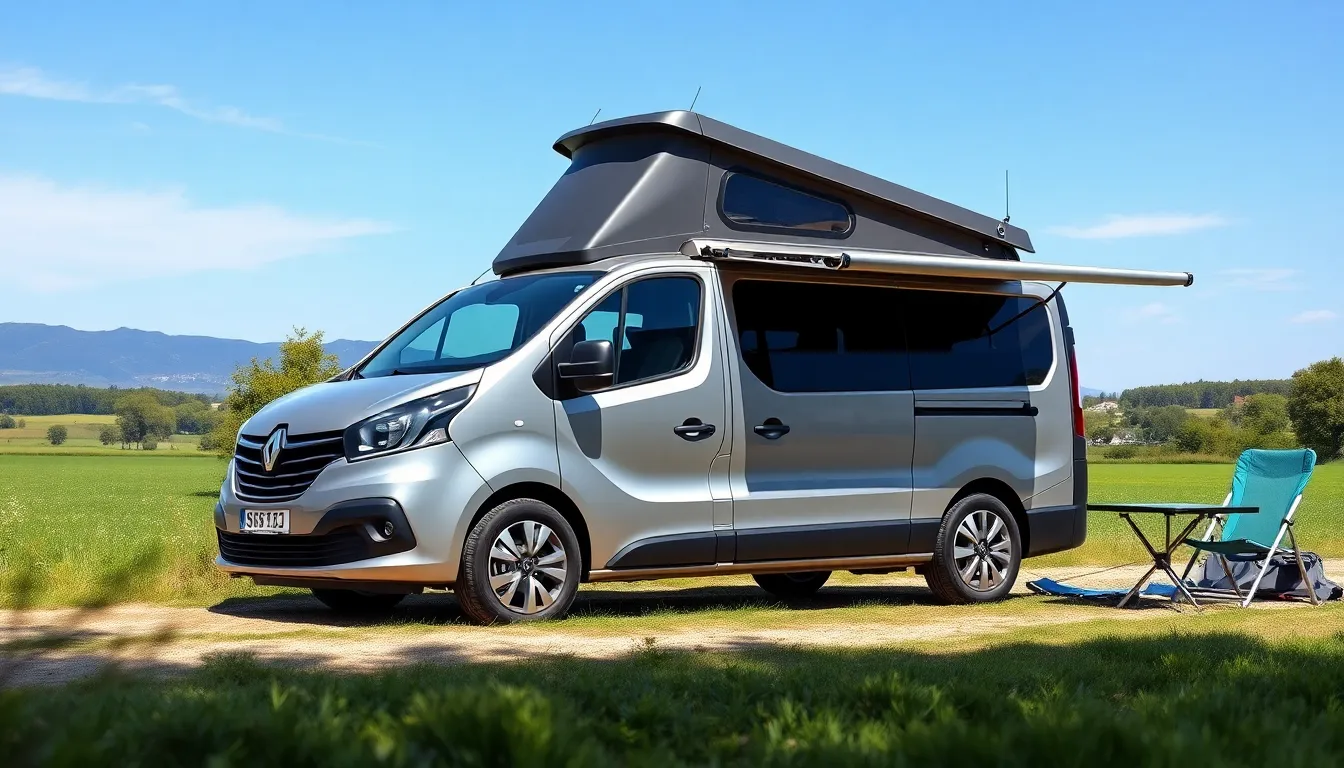
Modern Renault Trafic campers integrate advanced technological systems that enhance both safety and convenience during extended travel adventures. We’ve observed important improvements in driver assistance technologies across recent model years, with features like Electronic Stability Control (ESC) and Anti-lock Braking System (ABS) coming standard on all variants.
Driver Assistance Systems
Advanced driver assistance technologies in the Trafic camper provide comprehensive protection during long-distance journeys. Lane Departure Warning systems alert drivers when the vehicle begins drifting from marked lanes without signaling. Traffic Sign Recognition technology displays current speed limits and traffic signs on the dashboard display, helping maintain legal compliance across different regions.
Blind Spot Monitoring sensors detect vehicles in adjacent lanes and illuminate warning lights in the side mirrors. Rear Cross Traffic Alert systems warn drivers of approaching vehicles when reversing from parking spaces. Emergency Brake Assist automatically applies maximum braking force when sensors detect an imminent collision.
Infotainment and Connectivity
Entertainment and navigation systems in Trafic campers center around the MediaNav Evolution touchscreen display, available in 7-inch configurations. Apple CarPlay and Android Auto compatibility allows seamless smartphone integration for music streaming and hands-free calling. Built-in GPS navigation provides turn-by-turn directions with European mapping coverage.
USB ports throughout the cabin enable device charging for multiple passengers simultaneously. Bluetooth connectivity supports wireless audio streaming and phone calls through the vehicle’s speaker system. DAB+ digital radio reception ensures clear audio quality in remote camping locations.
Safety Equipment and Ratings
Structural safety features in the Trafic earned a 4-star Euro NCAP rating, demonstrating robust protection in collision scenarios. Six airbags provide comprehensive occupant protection, including front, side, and curtain airbags for all seating positions. Reinforced door frames and crumple zones absorb impact energy during accidents.
Electronic safety systems include Hill Start Assist, which prevents rollback on steep inclines, and Load Adaptive Control that adjusts braking force based on cargo weight. Tire Pressure Monitoring Systems alert drivers to low tire pressure conditions that could affect handling or fuel economy.
Security Systems
Anti-theft technologies protect both the vehicle and valuable camper conversion equipment from unauthorized access. Remote central locking systems secure all doors and windows with a single key press. Engine immobilizer technology prevents unauthorized engine starting without the correct key transponder.
Deadlocks on sliding doors provide additional security when parked overnight in remote locations. Optional alarm systems include motion sensors and glass break detectors that trigger audible warnings and hazard light activation. GPS tracking systems, when installed as aftermarket accessories, enable vehicle location monitoring through smartphone applications.
Pros and Cons of the Renault Trafic Camper
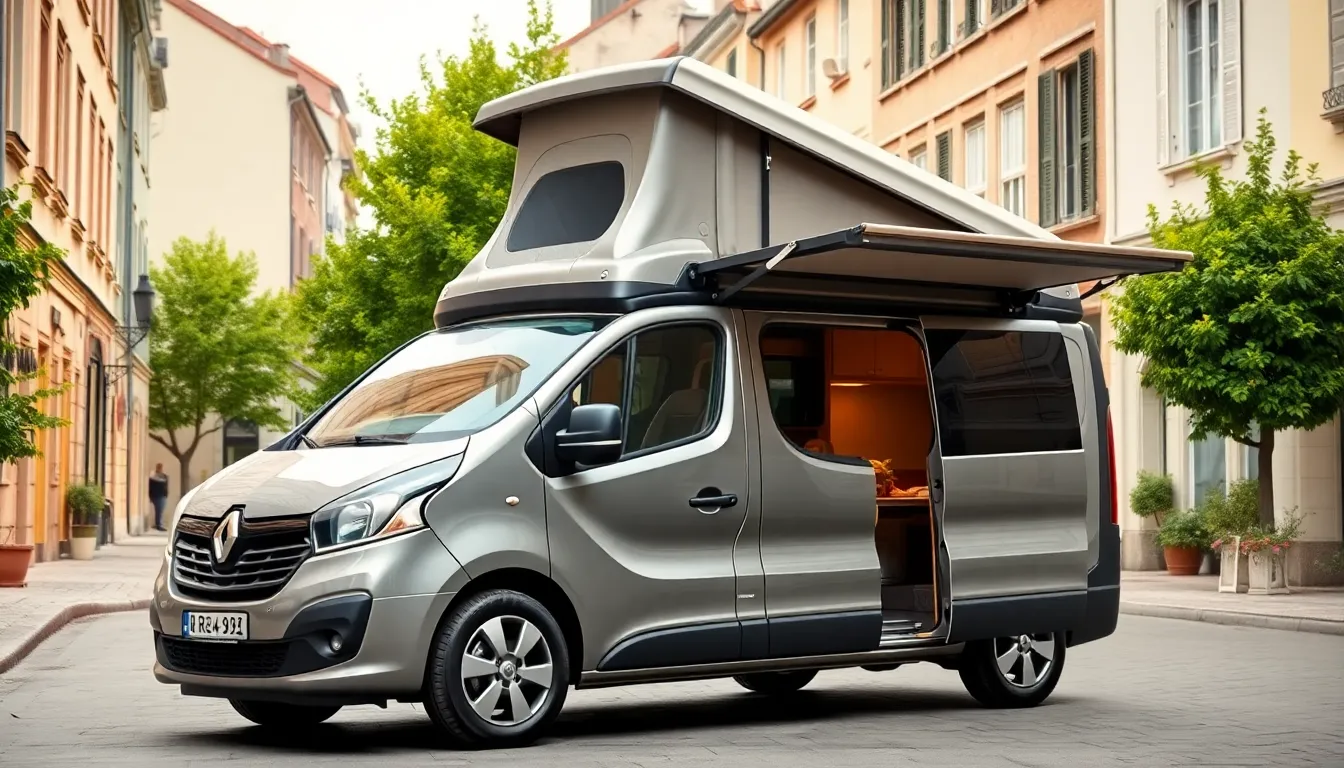
Every camper conversion comes with distinct benefits and limitations that impact the overall experience. We’ve identified the key advantages and disadvantages of choosing the Renault Trafic for your mobile living adventure.
Advantages
Affordability stands out as the Trafic’s primary strength, with base models starting around $35,000 and quality used options available between $15,000 and $25,000. Budget-conscious travelers save thousands compared to premium alternatives like the Mercedes Sprinter or Volkswagen Crafter.
Fuel efficiency delivers exceptional value during extended travel, achieving 35-40 mpg on highway driving with both Blue dCi engine configurations. Long-distance adventurers benefit from reduced fuel costs and extended range between fill-ups.
Compact dimensions enable navigation through narrow European streets and standard parking spaces that larger vans can’t access. Urban explorers and city travelers find this maneuverability invaluable when visiting historic centers and crowded destinations.
Interior space optimization maximizes living area within the compact footprint, particularly in the L2H2 variant measuring up to 5.98 meters in length and 1.90 meters in height. Conversion specialists appreciate the efficient use of every cubic meter for essential amenities.
Proven reliability stems from Renault’s commercial vehicle heritage and widespread service network across Europe and other markets. Professional converters and DIY enthusiasts benefit from readily available parts and maintenance support.
Modern safety features include Lane Departure Warning, Traffic Sign Recognition, and a 4-star Euro NCAP safety rating with multiple airbags. Safety-conscious travelers gain peace of mind during long journeys and challenging road conditions.
Disadvantages
Limited payload capacity restricts the weight of conversion components and personal belongings compared to larger commercial vehicles. Heavy-duty conversions require careful weight management to avoid exceeding legal limits.
Reduced headroom in standard height variants may feel cramped for taller individuals, with the L1H1 and L2H1 configurations offering less standing space than high-roof alternatives. Comfort levels vary significantly based on occupant height and interior layout choices.
Smaller water and waste tank capacity limits off-grid camping duration compared to larger motorhomes and Class B RVs. Extended boondocking requires more frequent resupply stops and careful resource management.
Engine power limitations become apparent when fully loaded on steep mountain passes or when towing additional equipment. The 120-150 horsepower range may feel underpowered compared to larger displacement engines in bigger vans.
Conversion complexity increases due to the compact interior requiring precise measurements and custom answers for optimal space utilization. DIY converters face steeper learning curves compared to more spacious platforms with established conversion kits.
Resale market considerations show lower demand compared to iconic models like the Volkswagen California, potentially affecting long-term value retention. Investment-minded buyers may find better resale prospects with more established camper van brands.
Pricing and Value for Money
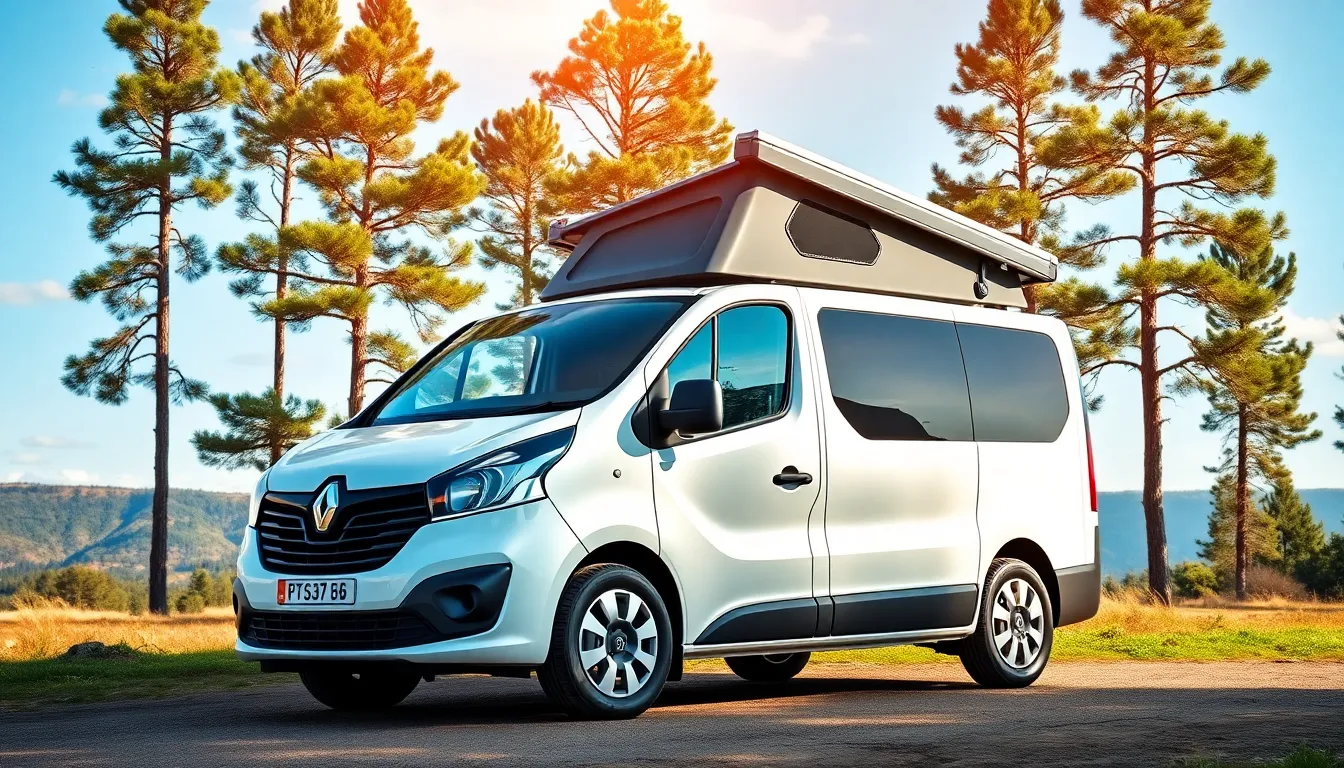
We find the Renault Trafic camper delivers exceptional value compared to premium alternatives in today’s conversion market. Base model Trafics start around $35,000 new while used options range from $15,000 to $25,000 depending on mileage and condition.
Conversion costs vary significantly based on your chosen approach and finish level. DIY conversions typically cost between $8,000 to $20,000 for materials and components while professional conversions range from $25,000 to $60,000 complete. Quality kitchen units add $2,500 to $5,000 to your budget while electrical systems including solar panels cost $1,500 to $4,000 installed.
Budget breakdowns for common conversion elements show clear cost advantages:
| Component | DIY Cost Range | Professional Install |
|---|---|---|
| Kitchen Unit | $1,200-$3,000 | $2,500-$5,000 |
| Electrical System | $800-$2,500 | $1,500-$4,000 |
| Insulation & Walls | $500-$1,200 | $1,200-$2,500 |
| Flooring | $300-$800 | $600-$1,500 |
| Windows & Vents | $400-$1,000 | $800-$1,800 |
| Bed & Furniture | $600-$2,000 | $1,500-$4,000 |
Our research shows the Trafic costs 30-40% less than equivalent Mercedes Sprinter conversions while maintaining similar functionality. Volkswagen Crafter alternatives command premium pricing with limited additional benefits for most users.
Fuel efficiency delivers ongoing value with the Trafic achieving 35-40 mpg during highway travel. Annual fuel costs remain manageable even with extensive touring compared to larger American based platforms that average 12-18 mpg.
Maintenance costs stay reasonable through Renault’s widespread dealer network and parts availability. Service intervals occur every 12,000 to 18,000 miles with routine maintenance averaging $300 to $500 per service.
Resale values hold steady for well maintained Trafic campers though they trail iconic models like the Volkswagen California. Depreciation rates average 15-20% annually for the first three years before stabilizing around 8-12% thereafter.
Insurance premiums reflect the van’s commercial vehicle classification with typical annual costs ranging from $800 to $1,500 depending on coverage levels and driver history. Modified vehicle policies may require specialized insurers but remain competitive.
Payload capacity limitations can increase conversion costs if lightweight components become necessary. Premium materials like carbon fiber or aluminum add 20-30% to component prices but preserve valuable weight allowances for water tanks and personal belongings.
Alternatives to Consider
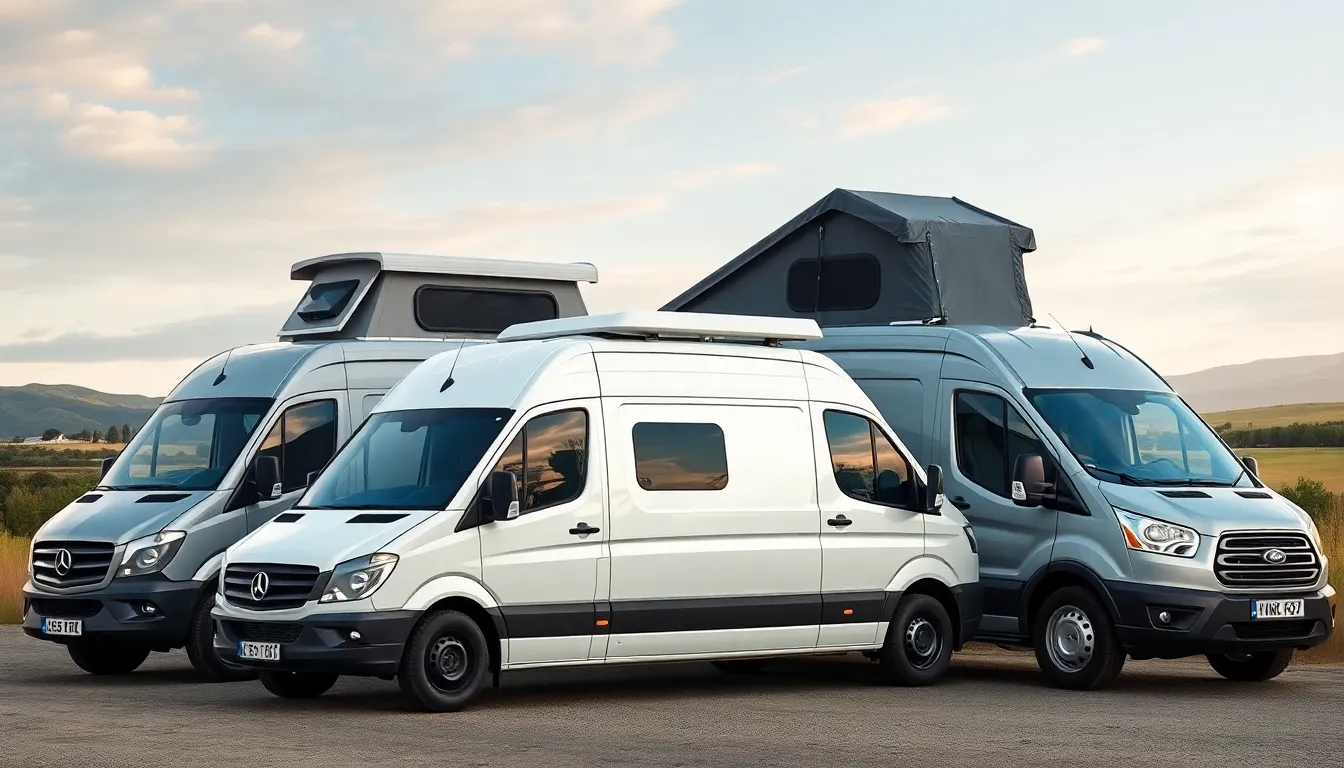
Several compelling alternatives exist in the commercial van camper market that compete directly with the Renault Trafic. Mercedes Sprinter leads the premium segment with starting prices around $45,000 for base models and conversion costs ranging from $35,000 to $80,000. The Sprinter offers superior payload capacity at 4,200 pounds compared to the Trafic’s 2,900 pounds, plus standing room in most variants with interior heights reaching 6.5 feet.
Volkswagen Crafter presents another European option with similar dimensions to the Sprinter but typically costs $3,000 to $5,000 less. Professional conversions for the Crafter range from $30,000 to $70,000, positioning it between the Trafic and Sprinter in both price and features. Ford Transit dominates the North American market with starting prices around $38,000 and widespread parts availability across the continent.
Iveco Daily stands out for overlanding enthusiasts with exceptional ground clearance and payload capacity exceeding 5,000 pounds in some configurations. Base models start around $42,000, though conversion costs often exceed $40,000 due to the van’s commercial focus. Nissan NV200 offers the most budget-friendly entry point at approximately $28,000 new, making it attractive for basic weekend camping setups.
Fiat Ducato shares mechanical components with the Renault Trafic but provides different styling and interior layouts. Starting prices mirror the Trafic at around $35,000, with conversion costs ranging from $20,000 to $55,000 depending on specification level. Ram ProMaster targets the American market with competitive pricing starting at $36,000 and front-wheel drive configuration that maximizes interior space.
| Vehicle | Starting Price | Conversion Cost Range | Payload Capacity | Interior Height |
|---|---|---|---|---|
| Mercedes Sprinter | $45,000 | $35,000 – $80,000 | 4,200 lbs | 6.5 ft |
| Volkswagen Crafter | $42,000 | $30,000 – $70,000 | 3,800 lbs | 6.3 ft |
| Ford Transit | $38,000 | $25,000 – $65,000 | 4,650 lbs | 6.25 ft |
| Iveco Daily | $42,000 | $40,000 – $75,000 | 5,000+ lbs | 6.4 ft |
| Nissan NV200 | $28,000 | $15,000 – $35,000 | 1,500 lbs | 5.5 ft |
| Fiat Ducato | $35,000 | $20,000 – $55,000 | 2,900 lbs | 6.2 ft |
| Ram ProMaster | $36,000 | $25,000 – $60,000 | 4,440 lbs | 6.4 ft |
Each alternative brings distinct advantages depending on exact requirements and budget constraints. Mercedes Sprinter excels in build quality and resale value but commands premium pricing throughout ownership. Ford Transit offers extensive dealer networks and parts availability, particularly beneficial for North American travelers. Iveco Daily suits adventurers requiring maximum payload and off-road capability, while Nissan NV200 serves budget-conscious buyers with basic camping needs.
Conclusion
We believe the Renault Trafic stands out as an exceptional choice for those entering the camper van lifestyle without very costly. Its combination of European engineering reliability fuel efficiency and practical dimensions makes it perfect for both weekend warriors and full-time travelers.
The Trafic’s versatility shines through its multiple configuration options and conversion-friendly design. Whether you’re planning a DIY build or working with professionals this van provides the foundation for creating your ideal mobile home.
While it may not offer the premium features of higher-end alternatives the Trafic delivers outstanding value that’s hard to match. For anyone seeking an affordable reliable and capable camper conversion the Renault Trafic deserves serious consideration in today’s competitive market.
Frequently Asked Questions
What is a Renault Trafic camper?
A Renault Trafic camper is a converted commercial van designed for mobile living. It features spacious interior dimensions up to 5.98 meters in length and 1.90 meters in height, with three body length options (L1H1, L2H1, and L2H2) to suit different space requirements. The conversion transforms the commercial van into a comfortable mobile home while maintaining the original 2.0-liter diesel engine for reliable transportation.
How much does a Renault Trafic camper cost?
New Renault Trafic base models start around $35,000, while used options range from $15,000 to $25,000. Conversion costs vary significantly: DIY conversions typically cost $8,000 to $20,000, while professional conversions range from $25,000 to $60,000. This makes it significantly more affordable than premium alternatives like Mercedes Sprinter or Volkswagen Crafter.
What fuel efficiency does the Renault Trafic achieve?
The Renault Trafic delivers impressive fuel economy of 35-40 mpg during highway driving. It features two primary diesel engine configurations: the Blue dCi 120 engine with 120 horsepower and the Blue dCi 150 engine with 150 horsepower, both meeting Euro 6d emission standards. This excellent fuel efficiency makes it economical for long-distance travel and extended adventures.
What are the main advantages of choosing a Renault Trafic for camper conversion?
Key advantages include exceptional affordability compared to competitors, excellent fuel efficiency (35-40 mpg), compact dimensions for easy urban navigation, optimized interior space utilization, proven reliability with robust European engineering, and modern safety features. The Trafic also offers standard roof rails for additional cargo capacity and sliding side doors for convenient access.
What are the limitations of the Renault Trafic camper?
Main limitations include limited payload capacity when fully loaded, reduced headroom in standard height variants, smaller water and waste tank capacities compared to larger vans, engine power limitations with heavy loads, increased conversion complexity, and potential resale market challenges compared to more iconic camper models like the Mercedes Sprinter.
How does the Renault Trafic compare to other camper van options?
The Trafic offers better value than premium alternatives like Mercedes Sprinter and Volkswagen Crafter while providing similar functionality at a lower cost. Compared to budget options like Nissan NV200, it offers more space and features. However, competitors like Ford Transit may have better parts availability in North America, and Iveco Daily offers superior payload capacity for overlanding.
What safety features does the Renault Trafic camper include?
The Trafic includes advanced driver assistance systems like Lane Departure Warning, Traffic Sign Recognition, and Blind Spot Monitoring. It earned a 4-star Euro NCAP safety rating with multiple airbags and electronic systems including Hill Start Assist and Tire Pressure Monitoring. Anti-theft features include remote central locking and optional alarm systems for enhanced security.
What conversion features can be added to a Renault Trafic?
Common conversion features include compact galley kitchens with essential appliances, flexible sleeping arrangements (fixed beds or convertible dinettes), strategic storage solutions with modular drawer units and overhead lockers, electrical systems for modern amenities, and insulation for comfortable living. The van’s interior height and space allow for comprehensive mobile home transformations.

